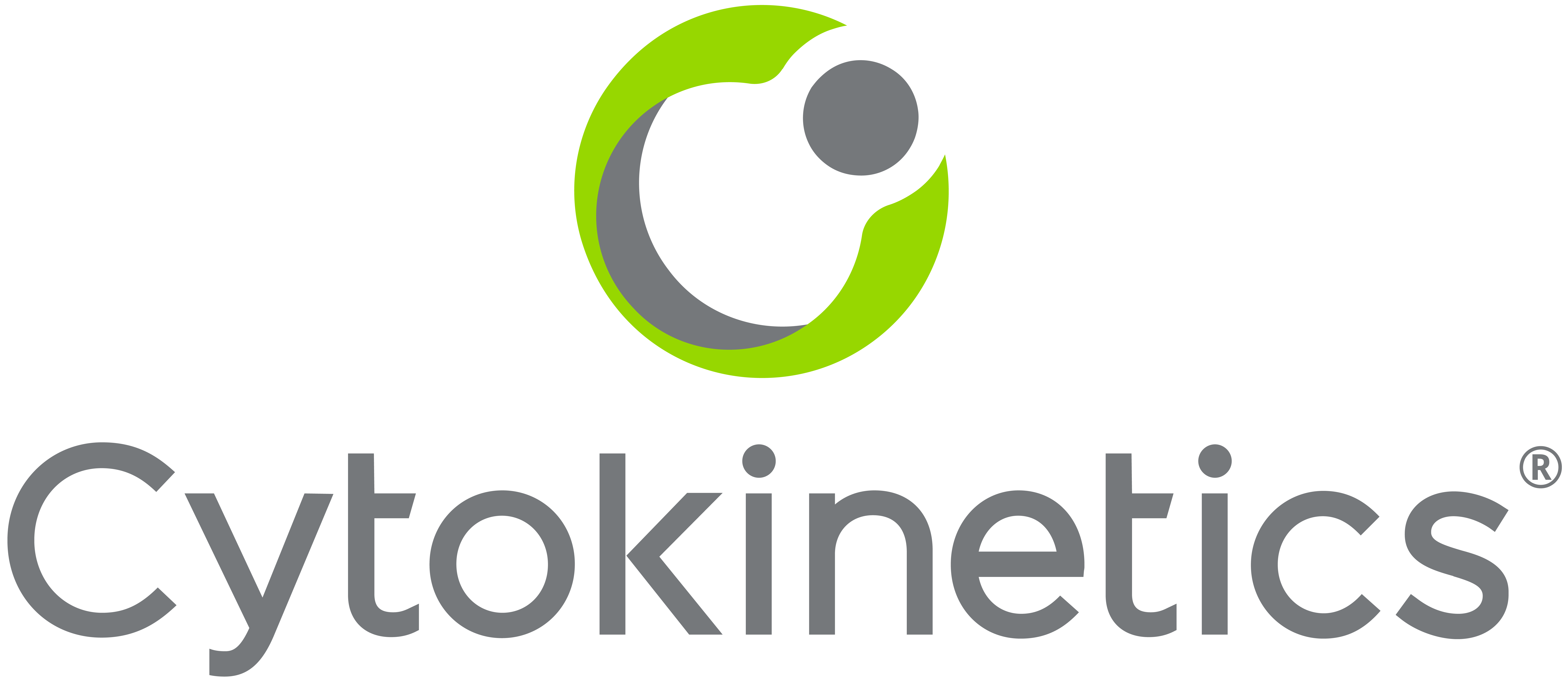Cytokinetics Announces Advancement of CK-2017357 in Phase I Clinical Trials
"With the initiation of our second Phase I clinical trial and Part B of our ongoing Phase I trial, we expect to gain additional insights into the pharmacokinetics of this novel mechanism drug candidate in healthy volunteers. In addition, we hope to begin to understand the impact this fast skeletal muscle troponin activator may have on the relationship between the force produced by a skeletal muscle and the frequency with which it is stimulated by the motor nerve supplying it, or more simply, the force-frequency relationship," stated Andrew A. Wolff, MD, FACC, Cytokinetics' Senior Vice President of Clinical Research and Development and Chief Medical Officer. "Observations from both of these clinical trials will inform our decisions regarding other metrics to assess in patient populations we intend to study in our Evidence of Effect clinical trials planned for 2010."
CK-2017357 is a fast skeletal muscle troponin activator and is the lead drug candidate from the company's skeletal sarcomere activator program. CK-2017357 selectively activates the fast skeletal troponin complex and increases its sensitivity to calcium, leading to an increase in skeletal muscle force. This mechanism of action has demonstrated encouraging pharmacological activity in preclinical models that may relate to the potential treatment of diseases associated with aging, muscle wasting or neuromuscular dysfunction.
Initiation of Multi-Dose Phase I Clinical Trial
In this clinical trial, two cohorts of at least 12 healthy male volunteers per cohort will be randomized to receive either CK-2017357 or placebo once daily for seven days. The primary objective of this clinical trial is to determine the safety and tolerability of CK-2017357 after multiple oral doses to steady state in healthy male volunteers. The secondary objective is to evaluate the pharmacokinetic profile of CK-2017357 after multiple oral doses to steady state.
Initiation of Part B in Ongoing Single-Dose Phase I Clinical Trial
In June 2009, Cytokinetics initiated the first part, or Part A, of a Phase I, first-time-in-humans, ascending, single-dose, double-blind, placebo-controlled clinical trial of CK-2017357, designed to assess the safety, tolerability, and pharmacokinetic profile of this drug candidate in healthy male volunteers and to determine its maximum tolerated dose and plasma concentration. Cytokinetics continues to dose volunteers in Part A of this trial. Each volunteer participates in two dosing sessions separated by an adequate washout period. Volunteers are randomized (3:1) at the start of each dosing period to receive active study drug or placebo, respectively. Although Part A of the trial is still ongoing and thus remains blinded, to date, no adverse events have been observed in trial participants to indicate that an intolerable dose has been administered. Consequently, the maximum tolerated dose has not yet been determined; however, doses that produced CK-2017357 blood levels associated with increased skeletal muscle function in preclinical models have been tolerated by the healthy volunteers in this study.
The second part, or Part B, of this Phase I clinical trial is a double-blind, randomized, placebo-controlled study of single doses that were tolerated in Part A of this trial. In order to assess the pharmacodynamic effect of CK-2017357 when administered orally to healthy male volunteers, the force-frequency relationship of an externally stimulated nerve-muscle pair and its relationship to CK-2017357 plasma concentration will be determined. A single cohort of volunteers will receive each of three single oral doses of CK-2017357 and oral placebo treatment in a 4-period crossover design; doses will be separated by an adequate washout period. Before and after dosing, the force exerted by the tibialis anterior muscle, measured by a foot flexion device at several different nerve stimulation frequencies, will be determined in order to establish the force-frequency relationship. In preclinical studies measuring this relationship, CK-2017357 appeared to shift the force-frequency curve upward and to the left, with more force being produced at nerve stimulation frequencies in the lower to mid-range of the force-frequency response. This part of the force-frequency response is generally the physiologic range of frequencies at which motor neurons stimulate skeletal muscle during normal function. Part B of this ongoing trial is designed to assess if that effect can be recapitulated in humans.
Background on Skeletal Muscle Activators
Skeletal muscle contractility is driven by the sarcomere, the fundamental unit of skeletal muscle contraction. It is a highly ordered cytoskeletal structure composed of several key proteins. The first, skeletal muscle myosin, is the cytoskeletal motor protein that converts chemical energy into mechanical force through its interaction with a second protein, actin. A set of regulatory proteins, which includes tropomyosin and three troponin subunits, make the actin-myosin interaction dependent on changes in intracellular calcium levels. Cytokinetics' skeletal muscle contractility program is focused to the discovery and development of small molecule skeletal sarcomere activators and leverages Cytokinetics' expertise gained from its ongoing discovery and development of cardiac sarcomere activators, including the cardiac muscle myosin activator, omecamtiv mecarbil, now in Phase II clinical development as a potential treatment for heart failure. In non-clinical models, skeletal sarcomere activators have demonstrated pharmacological activity that may lead to new therapeutic options for diseases associated with aging, muscle wasting or neuromuscular dysfunction. The clinical effects of muscle wasting, fatigue and loss of mobility can range from decreased quality of life to, in some instances, life-threatening complications. By directly improving skeletal muscle function, a small molecule activator of the skeletal sarcomere may potentially enhance physical performance and quality of life in patients with conditions marked by muscle weakness, including neuromuscular diseases such as amyotrophic lateral sclerosis (ALS) and myasthenia gravis, and other diseases and syndromes such as sarcopenia, claudication, cachexia, and the general frailty associated with aging.
Market Potential for Skeletal Muscle Activators
The conditions that could benefit from a skeletal muscle activator are grievous and severe. Few options exist for the treatment of ALS, which afflicts between 20,000 and 30,000 people in the United States, and is associated with a 3-year mortality rate of 50%. Another neuromuscular disorder, myasthenia gravis, a chronic disease characterized by a defect in the transmission of nerve impulses to skeletal muscles, afflicts approximately 60,000 patients in the United States. Patients with disorders and conditions with a higher prevalence could also benefit from enhanced skeletal muscle functional performance, including patients with cachexia, intermittent claudication and sarcopenia. Cachexia, a syndrome characterized by a drastic and unintentional loss of body mass, is estimated to be prevalent in 15%-35% of heart failure patients and in approximately 50% of cancer patients. Intermittent claudication, which usually refers to cramping pains in the legs caused by peripheral arterial disease, is a condition that impacts between 1 million and 3 million people in the United States each year. Sarcopenia, which is an age-related loss of muscle mass, strength, and function, is estimated to impact the lives of over 25-30% of the U.S. population over the age of 65 and can result in additional injuries and medical conditions due to limited mobility.
About Cytokinetics
Cytokinetics is a clinical-stage biopharmaceutical company focused on the discovery and development of small molecule therapeutics that modulate muscle function for the potential treatment of serious diseases and medical conditions. Cytokinetics' lead drug candidate from its cardiac muscle contractility program, omecamtiv mecarbil (formerly CK-1827452), is in Phase II clinical development for the potential treatment of heart failure. Amgen Inc. holds an exclusive license worldwide (excluding Japan) to develop and commercialize omecamtiv mecarbil and related compounds, subject to Cytokinetics' specified development and commercialization participation rights. Cytokinetics is independently developing CK-2017357, a skeletal muscle activator, as a potential treatment for diseases and conditions associated with aging, muscle wasting or neuromuscular dysfunction. CK-2017357 is in Phase I clinical development. Cytokinetics is also conducting non-clinical development of compounds that inhibit smooth muscle contractility and which may be useful as potential treatments for diseases and conditions such as systemic hypertension, pulmonary arterial hypertension or bronchoconstriction. In addition, prior Cytokinetics' research generated three anti-cancer drug candidates in Phase I clinical development: ispinesib, SB-743921 and GSK-923295. Cytokinetics is seeking a partner for ispinesib and SB-743921 and GSK-923295 is being developed under Cytokinetics' collaboration with GlaxoSmithKline. All of these drug candidates and potential drug candidates have arisen from Cytokinetics' research activities and are directed towards the cytoskeleton. The cytoskeleton is a complex biological infrastructure that plays a fundamental role within every human cell. Additional information about Cytokinetics can be obtained at www.cytokinetics.com.
This press release contains forward-looking statements for purposes of the Private Securities Litigation Reform Act of 1995 (the "Act"). Cytokinetics disclaims any intent or obligation to update these forward-looking statements, and claims the protection of the Safe Harbor for forward-looking statements contained in the Act. Examples of such statements include, but are not limited to, statements relating to the initiation, scope, design, conduct and results of Cytokinetics' research and development programs relating to skeletal muscle activators, including clinical trials for CK-2017357 and the significance of results of clinical trials and preclinical studies relating to Cytokinetics' skeletal muscle activators; the potential benefits of Cytokinetics' drug candidates and potential drug candidates, including the potential benefits of skeletal muscle activators; and the market potential for skeletal muscle activators. Such statements are based on management's current expectations, but actual results may differ materially due to various risks and uncertainties, including, but not limited to, potential difficulties or delays in the development, testing, regulatory approvals for trial commencement, progression or product sale or manufacturing, or production of Cytokinetics' drug candidates that could slow or prevent clinical development or product approval, including risks that current and past results of clinical trials or preclinical studies may not be indicative of future clinical trials results, patient enrollment for or conduct of clinical trials may be difficult or delayed, Cytokinetics' drug candidates may have adverse side effects or inadequate therapeutic efficacy, the U.S. Food and Drug Administration or foreign regulatory agencies may delay or limit Cytokinetics' or its partners' ability to conduct clinical trials, and Cytokinetics may be unable to obtain or maintain patent or trade secret protection for its intellectual property; Cytokinetics may incur unanticipated research and development and other costs or be unable to obtain additional financing necessary to conduct development of its products; Cytokinetics may be unable to enter into future collaboration agreements for its drug candidates and programs on acceptable terms, if at all; standards of care may change, rendering Cytokinetics' drug candidates obsolete; others may introduce products or alternative therapies for the treatment of indications Cytokinetics' drug candidates and potential drug candidates may target; and risks and uncertainties relating to the timing and receipt of payments from its partners, including milestones and royalties on future potential product sales under Cytokinetics' collaboration agreements with such partners. For further information regarding these and other risks related to Cytokinetics' business, investors should consult Cytokinetics' filings with the Securities and Exchange Commission.
Contact:
Christopher S. Keenan
Director, Investor & Media Relations
(650) 624-3000
SOURCE: Cytokinetics, Inc.



